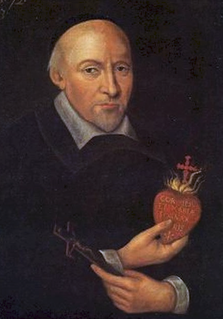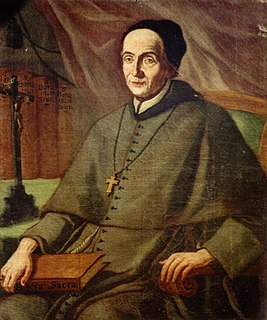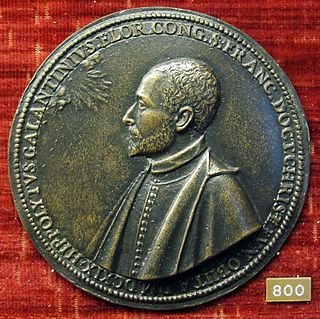
Blessed Anton Martin Slomšek was a Slovene Roman Catholic prelate who served as the Bishop of Lavant from 1846 until his death. He served also as an author and poet as well as a staunch advocate of the nation's culture. He served in various parishes as a simple priest prior to his becoming a bishop in which his patriotic activism increased to a higher degree since he advocated writing and the need for education. He penned textbooks for schools including those that he himself opened and he was a vocal supporter of ecumenism and led efforts to achieve greater dialogue with other faiths with an emphasis on the Eastern Orthodox Church.

Adolph Kolping was a German Catholic priest and the founder of the Kolping Association. He led the charge for providing and promoting social support for workers in industrialized cities while also working to promote the dignities of workers in accordance with the social magisterium of the faith.
Odo is a name typically associated with historical figures from the Middle Ages and before. Odo is etymologically related to the names Otho and Otto, and to the French name Odon and modern version Eudes, and to the Italian names Ottone and Udo; all come from the Germanic word ot meaning "possessor of wealth".

Bruno di Segni was an Italian Roman Catholic prelate and professed member from the Order of Saint Benedict who served as the Bishop of Segni and the Abbot of Montecassino. He studied under the Benedictines in Bologna before being appointed as the canon of the Siena cathedral and before he was invited to Rome where he became a bishop and counselled four consecutive popes. He served as an abbot in Montecassino but his chastising Pope Paschal II on the Concordat of Segni in 1111 prompted the pope to relieve him from his duties as abbot and ordered Bruno to return to his diocese where he died just over a decade later. Bruno's canonization was celebrated on 5 September 1181 under Pope Lucius III who presided over the celebration in the late bishop's diocese.

John Eudes was a French Roman Catholic priest and the founder of both the Order of Our Lady of Charity in 1641 and Congregation of Jesus and Mary also known as The Eudists in 1643. He was also a professed member of the Oratory of Jesus until 1643 and the author of the proper for the Mass and Divine Office of the Sacred Hearts of Jesus Christ and the Blessed Virgin. Eudes was an ardent proponent of the Sacred Hearts and dedicated himself to its promotion and celebration; the Masses he compiled for both Sacred Hearts were both first celebrated within his lifetime. He preached missions across France, including Paris and Versailles, while earning recognition as a popular evangelist and confessor. Eudes was also a prolific writer and wrote on the Sacred Hearts despite opposition from the Jansenists.

Saint Silvestro Guzzolini was an Italian Catholic priest and the founder of the Silvestrini. He served as a canon in Osimo but respectful rebukes of his bishop's inappropriate conduct led him to leave for a hermitage before the bishop could strip him of his position. He remained in his hermitage with a determination to found a religious congregation and based it upon the Order of Saint Benedict after having a dream of Saint Benedict of Nursia. His order received papal approval from Pope Innocent IV which allowed his order to expand across Italian cities to a significant degree.

Antonio Lucci, born Angelo Nicola Lucci, was an Italian Roman Catholic professed member from the Order of Friars Minor Conventual and served as the Bishop of Bovino from 1729 until his death.

Ippolito Galantini was an Italian Roman Catholic and the founder of the Congregation of Christian Doctrine. Galantini became a noted educator in Florence and Pope Leo XI - an associate of his - dubbed Galantini as the "Apostle of Florence" due to his activism in educational affairs. He was subject to malicious attacks - even one failed assassination attempt - and was once accused of harboring heretical views though was exonerated from all charges.
Guillaume de Donjeon was a French Roman Catholic prelate who served as the Archbishop of Bourges from 1200 until his death. He served as a canon in Soissons and Paris before he entered the Order of Grandmont. Sometime later he entered the Cistercians. He was known to practice austerities such as abstaining from meat and wearing a hair shirt.
Pacificus da Ceredano - born Pacificus Ramati - was an Italian Roman Catholic priest and a professed member from the Order of Friars Minor. Pope Benedict XIV approved his "cultus" and beatified him on 7 July 1745.

Agostino Roscelli, also known as Augustine Roscelli, and Augustin Roscelli, was an Italian priest who inspired social change in Genoa, Italy for children and disadvantaged women. He was canonized a saint in the Roman Catholic Church in 2001 by Pope John Paul II.

Luigi Maria Monti was an Italian Roman Catholic professed religious and the founder of the Sons of the Immaculate Conception. He was referred to as "Father" despite not being an ordained priest. Monti served as a nurse for most of his life and aided the ill in the Santo Spirito hospital in Rome while he was there and also worked to tend to ill people during the Brescia cholera epidemic in 1855. Monti also considered entering the religious life and joined the order of Lodovico Pavoni for a brief period of time though became a religious of his own order later on.
Blessed Edoardo Giuseppe Rosaz was an Italian Roman Catholic prelate who served as the Bishop of Susa from 1877 until his death and was the founder of the Franciscan Mission Sisters of Susa. He served as a simple priest before his episcopal appointment was announced - at Saint Giovanni Bosco's suggestion - and his apostolic zeal became even greater as a bishop when he tended to abandoned people in the peripheries and encouraged the work of a range of different religious orders.

Luigi Biraghi was an Italian Roman Catholic priest who served in his home of Milan. Biraghi later went on to establish his own religious congregation known as the Sisters of Saint Marcellina.
Giuseppe Baldo was an Italian Roman Catholic priest and the founder of both the Little Daughters of Saint Joseph (1894) and the Sisters of Charity of Saint Mary (1882). Baldo served as a simple parish priest in the Diocese of Verona and tended to the old and the poor.
Andrea Franchi was an Italian Roman Catholic member of the Order of Preachers who served as the Bishop of Pistoia before his resignation due to ill health. Franchi became a noted preacher and evangelist who was also known for his holiness and his deep commitment to the poor of his diocese.
Giacomo Benefatti was an Italian Roman Catholic priest and professed member of the Order of Preachers who ascended to the position of Bishop of Mantua. Benefatti became noted for his tender care of the ill during epidemics of plague and both Pope Benedict XI - a close personal friend - and Pope John XXII held him in high esteem.
Aimone Taparelli was an Italian Roman Catholic priest and a professed member from the Order of Preachers. He served as an Inquisitor-General for his order in the Lombard and Liguria regions and became a travelling preacher in northern Italian cities.
Antonio Pavoni was an Italian Roman Catholic priest and a professed member from the Order of Preachers. He served as an inquisitor-general for Pope Urban V in combatting Waldensians in the Lombard region but the Waldensians succeeded in killing him in an ambush as he presided over a sermon just after Easter in 1374.

Gabriel Ferretti was an Italian Roman Catholic priest and a professed member from the Order of Friars Minor. He was an ancestor to both Cardinal Gabriele Ferretti and Pope Pius IX having been descended from a long noble lineage. Ferretti entered the religious life after becoming of age and soon after his ordination held two important leadership positions in the order. He set about restoring run down Franciscan convents in the region as well as seeing to the establishment of new ones to deal with an influx of new novices.











